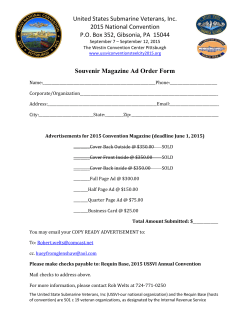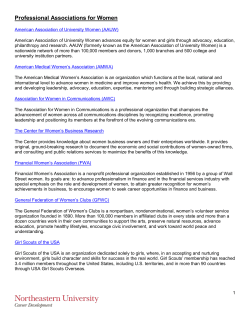
862 Kb
Understanding the Association Market and Convention Business Saint Petersburg 2014 Content: 1. 2. 3. 4. 5. Anatomy of Associations Conventions vs. Other Markets Convention Market Profile Trends and Business Drivers Marketing to Associations Definition of Association Two or more entities with a shared objective Conventions - Business Objectives Political – G20 Summit Religious - World Ecumenical Forum Economics - World Economic Forum Scientific - World Genetics Congress Trade - Intl. Union of Food Science & Technology Professional - International Chartered Accountants Interest groups - Windows User Group World organisations - Rotary Sports - IOC Types of Associations Trade = Company members, represent the interest of an industry Lobbying Standard setting / maintenance Promotion Business development Education Types of Associations Professional (Professional Society or Community) = Individual members, represent the interest of people or a profession Education Certification Voluntary Non-voluntary Networking Buyers / Suppliers Types of Associations User Groups (mainly technology) = Customer Communities Users of a specific vendor Independence Education Networking Product enhancement Types of Associations Federations = Association of Associations Limited mandate Avoid competition Share resources Define roles “who owns what pieces of the pie?” Intra-industry dialogue Example of a Federation Nature of Associations Not for profit organisations Non government organisations (NGOs) o o o Organised independently from government Often to pursue a wider social aim That may have policy implications (influencing government policy, not making it) What Associations Do Political lobbying Standard setting, accreditation, self regulation Industry promotion Business development Education Industry trends and research Product development (user groups) The Association Model Goal: Deliverables: Activities: Member Value Professional Development Certification Business Development Industry Development Education Standards Meetings Industry Trends & Research Communications & Lobbying Board Governance: Staff Management: Resources: Business Networking Regulatory Environment Member Fees Membership Volunteers Participation Fees Corporate Support Content: 1. 2. 3. 4. 5. Anatomy of Associations Conventions vs. Other Markets Convention Market Profile Trends and Business Drivers Marketing to Associations The Convention and Exhibition Industries vs. Tourism and Leisure Tourism Conventions & Exhibitions Participants Tourists Professionals / Business People Participant Motivations Fun / Self Actualization Business / Networking / Learning Purpose of Visit Leisure Work Related Customer Needs Bargains High Level of Service and Product Buyers Tour wholesalers / Travel agents Meeting Planners / AMCs / PEOs Buyer Motivations Fees & Commissions Successful Meetings / Profitable Shows Decision Criteria Destination Appeal Facilities / Business Links / Market Issues Buyer Service Needs Reservations / Itineraries Housing / Registration / Event Services Distribution Channels Travel Agents / Tour Wholesalers / GDS Corp and Association HQs / AMCs / PEOs Supply Chain Hospitality Industry PCOs / DMCs / Venues / Event Suppliers Market Approach Advertising / Marketing / Packaging Direct Sales Securing the Business Strategic / Marketing Oriented Tactical / Sales Oriented Size of Groups Individuals or small groups 300 – 10,000 delegates Main Economic Impact Direct Spending Trade and Investment Experienced Tourism Offices Not Experienced Conventions vs. Other Markets Location of meetings Influencers Association Well known cities Easy access Good infrastructure Association Association Board of Directors, Chapters, Members, Meeting planner, committees, Board Staff, AMC of Directors Association Delegates decide and pay to attend (Marketing) Corporate Smaller luxury hotels HQ/Branch locations Corporate Customers and Clients VP of Sales Corporate Meeting planner, VP of Sales Corporate Company decides and pays Incentive Emerging destinations Luxury oriented Sizzle Incentive Clients and employees, purchasing, VP of sales, program objectives Incentive Third party (incentive house companies) Incentive Winners attend Decision Makers Attendance Content: 1. 2. 3. 4. 5. Anatomy of Associations Conventions vs. Other Markets Convention Market Profile Trends and Business Drivers Marketing to Associations Tracking the Industry International Convention & Congress Association Meetings must have 50 participants minimum be organised on regular basis move between at least 3 countries Union of International Associations (UIA) Meetings must have 300 participants minimum 40 % foreigners Nationalities: 5 Minimum duration: 3 days ICCA & UIA statistics do not reflect the whole market Exclude national meetings (tremendous impact on overnights) Exclude all international meetings not qualified Exclude the corporate market (meetings, incentives, product launches) Where Associations are Based International Association HQs Source: ICCA Statistics 2010 Where Conventions Meet Convention Rotation Patterns - 2013 3.3% Worldwide 5.8% Europe Asia/Pacific 45.2% 30.3% Latin America Asia Europe/North America Interamerican Nordic Countries Ibero-America Source: ICCA Statistics 2013 Size of Conventions Number of Delegates at Conventions 2008 - 12 12.10% 5.10% 3.00% Under 250 250 - 499 56.30% 500 - 999 1,000 - 1,999 23.50% Over 2,000 79.8% have attendance of 500 or less Source: ICCA Statistics 2013 When Conventions Meet Source: ICCA Statistics 2013 How Frequently Conventions are Held 3.1% 10.6% 2.0% 4.7% Annual Biennial 22.0% 57.6% Triennial Every 4 years Biannual Other Source: ICCA Statistics 2013 Convention Venue Preference Conventions Held in 2008 - 12 9.20% 22.40% 44.20% Hotels Convention Centres 24.30% University Other Source: ICCA Statistics 2013 How Far in Advance Conventions Decide on Destinations Medium to Long term planning National: 1 – 2 years Regional: 2 – 4 years Global: 4 – 7 years Key Issues Longer term focus Understanding the difference between business occurring and future business booked Relates to investment and effort over the past 5 years 2010 2011 2012 Future business booked in 2015 and when it will occur 2013 Business Occurring in 2015 and when it was booked 2014 2015 2016 2017 2018 2019 2020 Relates to 2015 investment and effort Content: 1. 2. 3. 4. 5. Anatomy of Associations Conventions vs. Other Markets Convention Market Profile Trends and Business Drivers Marketing to Associations Examples of Key Association Trends Generation change Globalization / Emerging markets Event rotation Extended reach of events Risk adversity Safety Social media CSR / legacy Increasingly crowded market Emphasis on outcomes, not destinations Examples of Key Association Drivers Financial Outcomes o Costs / Revenues / Subvention ROI Transparency Professional management Partnerships Convenience They Often Want to Work Through CVBs Client Expectations One stop shop Impartial advice Destination Information and Support Coordinating Bids Liaison with Government / Airlines Non-Commercial / Independent / Unbiased Destination Selection - Associations Step 1: Qualification (Information) Adequate air access? Adequate congress facility? Adequate hotel package? Adequate service? Step 2: Short listing – (Processing) Step 3: Differentiation – (Being sold) Price/value Will the meeting achieve its goals? Will my delegates want to go there? Qualitative issues “Hygene Factors” Competitive Factors Strengths and weaknesses analysis of your destination and of the competing destinations. Bidding • CB experience • Professional network • Unified sales approach • Subvention • Business image Economic • Demand base • Supply base • Corporate base • Innovation • Population • Economy • GDP Staging • Location • Air access • Air convenience • Customs & Immigration • Distance from airport • Logistics • Hotel stock • Facility package • Meeting space • Plenary seats • Exhibition space • PCOs & DMCs • Exhibition service support • Association member interest • Exhibitor interest • Incentive participant interest • Value Source: GainingEdge City Competitiveness Scoring System Destination • New to rotation • Industry experience • Destination appeal • Service standards • Skilled labour • Safety & security • National capital • Entertainment • Food • Shopping • Resorts Key Destination Issues Local Experience and expertise Local support i.e. Government & industry Cost / Subvention Strength of local industry / host organisation Affordability Safety and security Compatibility with Organisational goals Examples: - New membership potential - Research in developing countries - Financial results Destination appeal for delegates (less important than it used to be) Other Factors Universities and scientific institutions Local expertise in area of interest International headquarters and corporations Sponsor support Competitive prices Efficient Convention Bureau Professional service structure (well coordinated supply) Political fit or advantage Promoting a cause Avoiding places that conflict with cause Content: 1. 2. 3. 4. 5. Anatomy of Associations Conventions vs. Other Markets Convention Market Profile Trends and Business Drivers Marketing to Associations Marketing to Associations Research ICCA (International Congress and Convention Association) UIA (Union of International Associations) ESAE (European Society of Association Executives) IAPCO (International Association of Professional Conference Organisers) Marketing to Associations Leads Development Identify key industry strengths within city / country / region Indentify major R & D facilities i.e. research institutes, universities Key government priorities for development and growth Find matching international association Marketing to Associations Bid Development Obtain bid criteria Match against destinations credentials Prepare and implement bid strategy Marketing to Associations Sales Development Trade shows Europe – EIBTM, IMEX North America – ASAE, PCMA, IMEX America, AIBTM Asia – AIME, IT & CMA, GIBTM Conference – ICCA, DMAI, MPI, UIA Sales calls Site inspections Thank You
© Copyright 2025














